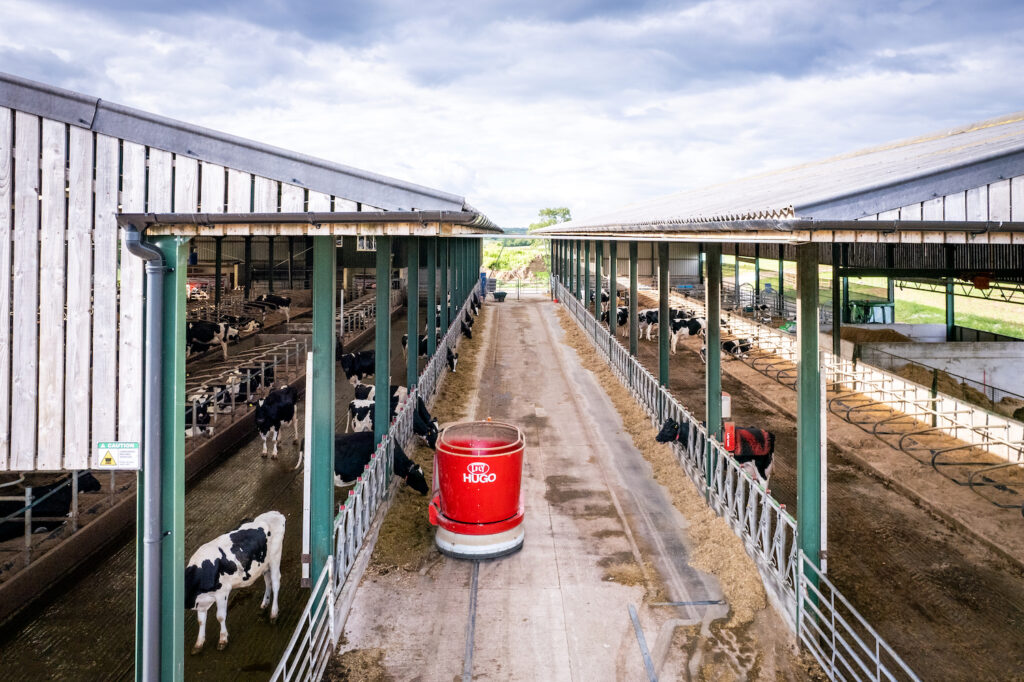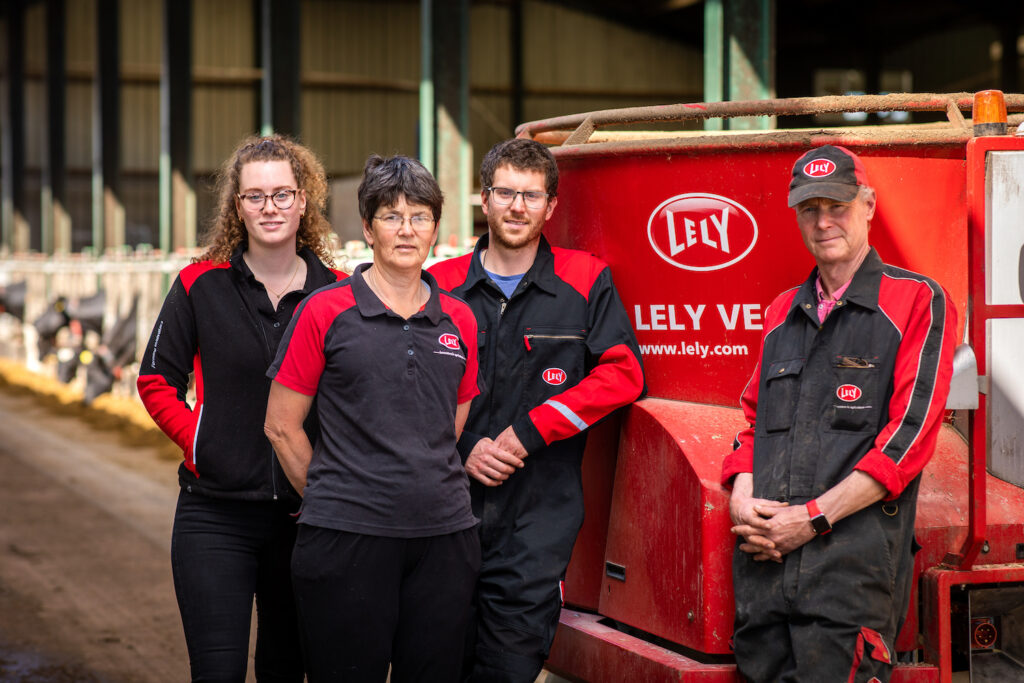Attention to detail ensures high yields on Shropshire dairy farm
9th February 2023
Attention to detail, especially during the transition period, is helping ensure high yields on Lower Lee Farm in Shropshire.

Image © Portland Productions/Lely.
Careful cow selection and management, coupled with the latest technology, is driving annual average milk yields of 11,500 litres at Lower Lee Farm.
The farm, located near Lee Brockhurst to the north of Shrewsbury, is home to a high-input, high-output dairy enterprise run by Jeff and Judith Lester, in partnership with their son George, with the support of their daughter Izzy, who works for Lely.
The family keeps a 180-cow herd of pure Holsteins on a state-of-the-art site at their 350-acre farm – it features three Lely milking robots, a Lely robotic feeding system and automatic scrapers.
“In 2007 our cowman wanted to retire, and we wondered what to do with the farm,” says Jeff.
“We had some quite nice, old farm buildings and someone suggested getting planning permission to get them converted into housing and to take the money and build a new greenfield site down the road.”
He says the economic crash of 2008 put the plans on hold, until five years ago when the old buildings were sold, and construction started on a new custom-built dairy.
Robotic technology
The Lesters originally planned to build a new dairy unit with two robotic milkers, however the plans evolved while the family waited for the housing market to improve.
After trialling a milking robot on the old site and being impressed with its performance, they decided to install three robots at the new site – two Lely A4s and one Lely A5 – as well as the company’s Vector automatic feeding system.
“The custom-made dairy set-up is perfect for what we need,” says Jeff.
He says the Vector system works via a robotic mixer wagon – this can hold approximately 600kg of feed – which is fed using a robotic crane on a gantry in a part of the barn he refers to as “the kitchen”.
“If you imagine a game with a little crane with a grabber on the end – where you can control it to move left and right, and forwards and backwards – it’s like that, but on a massive scale,” adds Jeff.
“All the feed is laid out on a grid system – for example A1 is grass silage and A3 is maize silage – and you tell it what you want to feed the cows.
“It then picks it up, weighs it and puts it in the mini feeder wagon; this trundles off to feed the cows and push up feed. It’s a really elegant system.”
He says the robotic feeder wagon feeds little and often, which helps reduce waste and ensures the cows always have fresh food in front of them.
“It took a long time to get over the shock of seeing very little food at the feed fence, but it’s better presented and reduces the stress impact on the cow,” adds Jeff.
“You get an increase in dry matter intake because they eat more silage.”

(l-r): Izzy, Judith, George and Jeff Lester. © Portland Productions/Lely.
Genetic focus
The Lesters believe a close focus on the genetic potential of the cattle is key to ensuring they achieve yield potential.
“We genetically test every heifer, and we’re part-way through building a picture of the whole herd,” explains Jeff.
“When we’re testing, we look at yield potential and Production Index (PI), as well as specific robotic milking traits, like long rear teats, and wide placement of the teats.”
He says the aim of genetic testing is to ensure only the best cattle are being used to breed replacements, and to help find any “superstars” in the herd, that can be flushed and bred from further.
The Lesters run a 25% replacement rate and sexed Holstein semen is used on heifers who score highly in genetic testing, as well as cows which have bred well in the past or previously scored highly during genetic testing when they were heifers.
Everything else is bred to British Blue genetics using AI, and all dairy beef calves are sold at market before they reach 42-days-old.
Transition management
An all-year-round calving system is run at Lower Lee Farm to ensure continuous supply of milk to Tesco, via Muller.
And while genetics play an important part in ensuring optimal milk production, the Lesters also believe a close focus on transition cow management is key to ensuring cows reach their yield potential.
The milking herd ration contains a mix of home-grown forage – roughly two-thirds maize, and one-third grass – and a blend, whereas the transition cow diet comprises mostly straw, with a small amount of maize and grass silage.
“We keep the dry cows together so they’re in the same group from when we dry them off until they calve,” says Jeff.
“They’re in cubicles with sand, which are slightly longer and bigger to make them more comfortable, and there’s lots of feed space so there’s no competition for food.”
He says Kexxtone – a monensin bolus – is given to at-risk dry cows to prevent ketosis and any related health problems after they have calved.
This is given to any cattle based on the SOFT analogy – this means giving the boluses to any sick, old, fat, thin or twin bearing cows.
“We’ve been using the boluses successfully for around five years now,” says Jeff.
“We chose to start administering these because we believe if your cow doesn’t calve down and get off to a flying start, she is never going to reach her yield potential.
“Our cows are like Olympic athletes, or Formula 1 racing cars – they’re at the top of their game, but it doesn’t take much to knock them down. Prevention is key and hopefully we don’t get as many transition problems because we use the boluses sensibly.”
Farm facts
- Family farm run by Jeff and Judith Lester, and their son George
- New custom state-of-the-art dairy set-up featuring three Lely robots, the company’s Vector feeding system and automatic scrapers
- 180-cow pure Holstein herd giving average annual yields of 11,500 litres
- All-year-round calving with genetic testing used to select the best heifers and cows for breeding with sexed Holstein semen. Everything else goes to British Blue
- Close focus on transition management, including the use of Kexxtone monensin boluses for at-risk cows, to prevent ketosis and ensure yield potential is reached.
